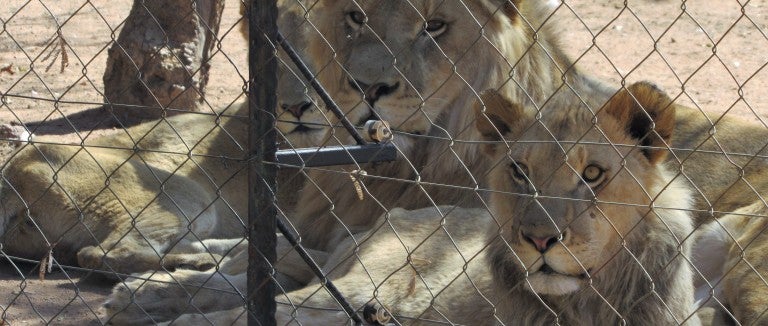What is captive hunting?
Captive hunting operations—also referred to as "shooting preserves," "canned hunts" or "game ranches"—allow trophy hunters to shoot animals who are fenced in. The animals are often semi-tame—some have even been hand raised or bottle fed by humans. Operators often offer customers a guarantee of “no kill, no pay,” or boast about their “100% success” rate.
The HSUS estimates that there are likely thousands of captive mammal hunting operations in at least two dozen states, with Texas having the highest number. Several factors are feeding this expanding industry: The overbreeding of captive exotic animals, the desire by some hunters with plenty of cash for a quick and easy kill, and the incentive to bag exotic mammals provided by Safari Club International's "Introduced Trophy Game Animals of North America" trophy hunting achievement award.
What do hunters say about captive hunting?
Ethical hunting allows animals the chance to get away. Mainstream hunters condemn captive hunting as unsportsmanlike and unethical. These practices violate the widely accepted doctrine of “fair chase,” because the hunter has all the advantages.
The self-described ethical hunting community (including groups like Boone & Crockett, Pope & Young, and the Izaak Walton League) is becoming increasingly vocal in its opposition to captive hunting.
As hunter and noted author Ted Kerasote puts it, "'Canned hunting' is a misnomer. More accurately defined as 'shooting animals in small enclosures,' the activity has nothing to do with the motives that inform authentic hunting: procuring healthy, organic food; participating in the timeless cycles of birth, death, and nurturing; honoring the lives that support us; and reconnecting with wildness. No matter where one stands on hunting—vehemently opposed to it or seeing it as yet another way to live sustainably on Earth—one ought to decry shooting animals behind fences."
The Boone and Crockett Club issued the following position statement on their website: “The Boone and Crockett Club is opposed to canned shoots because they contravene the principles of Fair Chase, the ethical code of hunting conduct at the core of the Club’s Mission. One of the most basic tenets of Fair Chase is ensuring an animal has a reasonable opportunity to escape. If it does not, the hunt cannot be considered ethical. The Club recommends that all hunters and hunting clubs or organizations discourage the practice of canned shoots because it violates the principles of Fair Chase.”
What animals are killed in captive hunting?
The animals killed in captive hunts may come from private breeders, animal dealers, circuses or even roadside zoos. These animals are frequently hand-raised and bottle-fed, so they have lost their natural fear of people. In many facilities, the animals expect to be fed at regular times at feeding stations—a setup that guarantees a kill for trophy hunters.
How does captive hunting hurt endangered species?
Some animals offered to customers in captive hunts include threatened or endangered species. Although the Endangered Species Act (ESA) protects animals listed as endangered or threatened, the U.S. Fish and Wildlife Service issues permits for certain of these listed species to be killed in captive hunts. This creates a market for endangered species’ trophies and can encourage illegal poaching of the animals in the wild. It contradicts the basic purpose of the ESA, which is to conserve endangered and threatened wildlife – not shoot them for trophies.
For example, Scimitar-horned oryx, Arabian oryx, dama gazelle, addax, barasingha and red lechwe are all species listed under the ESA, yet captive hunt customers have been able to kill all of these species.
How does captive hunting spread disease?
The high population densities of captive hunts increase the risk of diseases being spread between animals. Diseases such as tuberculosis and brucellosis—which can also infect farm animals and other wildlife—have been diagnosed in captive wildlife. Chronic wasting disease, a fatal disease that infects deer, elk, and moose, is another serious concern. CWD has been reported in 31 states; in 15 of these states CWD was present in captive wildlife.
Although there must legally be fencing around captive hunts, animals can and do escape from these facilities. The interstate transport of animals for breeding purposes increases the possibility of spreading diseases even farther. Through escaped animals, fence-line transmission, or environmental contamination, game farms and captive hunting ranches are putting our wild herds at grave risk.

